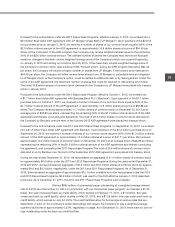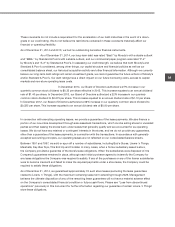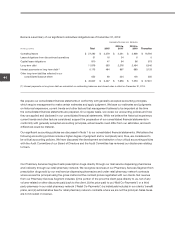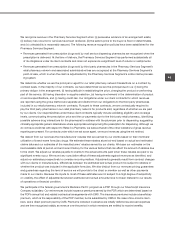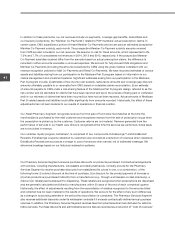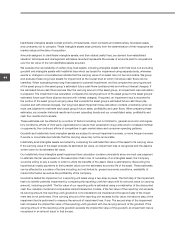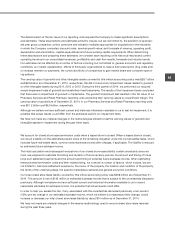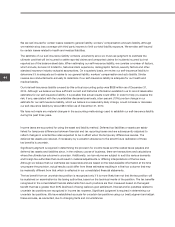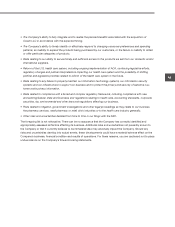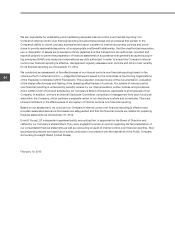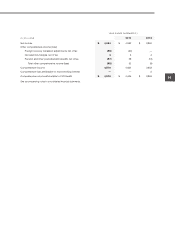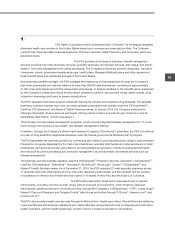CVS 2014 Annual Report Download - page 49
Download and view the complete annual report
Please find page 49 of the 2014 CVS annual report below. You can navigate through the pages in the report by either clicking on the pages listed below, or by using the keyword search tool below to find specific information within the annual report.
47
2014 Annual Report
New Accounting Pronouncement
In May 2014, the Financial Accounting Standards Board (“FASB”) issued Accounting Standard Update (“ASU”)
No. 2014-09, Revenue from Contracts with Customers (Topic 606). ASU No. 2014-09 outlines a single comprehen-
sive model for entities to use in accounting for revenue arising from contracts with customers and supersedes most
current revenue recognition guidance, including industry-specific guidance. This new guidance is effective for annual
reporting periods (including interim reporting periods within those periods) beginning after December 15, 2016; early
adoption is not permitted. Companies have the option of using either a full retrospective or a modified retrospective
approach to adopt the guidance. This update could impact the timing and amounts of revenue recognized. The
Company is currently evaluating the effect that implementation of this update will have on its consolidated financial
position and results of operations upon adoption and the method of transition.
Proposed Lease Accounting Standard Update
In May 2013, the FASB issued a revised proposed accounting standard update on lease accounting that will require
entities to recognize assets and liabilities arising from lease contracts on the balance sheet. The proposed account-
ing standard update states that lessees and lessors should apply a “right-of-use model” in accounting for all leases.
Under the proposed model, lessees would recognize an asset for the right to use the leased asset, and a liability for
the obligation to make rental payments over the lease term. The lease term is defined as the noncancelable term
that takes into account renewal options and termination options if it is reasonably certain an entity will exercise or
not exercise the option. The accounting by a lessor would reflect its retained exposure to the risks or benefits of the
underlying leased asset. A lessor would recognize an asset representing its right to receive lease payments based
on the expected term of the lease. The Company cannot presently determine the potential impact the proposed
standard would have on its results of operations. While the Company believes that the proposed standard, as
currently drafted, will likely have a material impact on its financial position, it will not have a material impact on its
liquidity; however, until the proposed standard is finalized, such evaluation cannot be completed.
Cautionary Statement Concerning Forward-Looking Statements
This annual report contains forward-looking statements within the meaning of the federal securities laws. In addition,
the Company and its representatives may, from time to time, make written or verbal forward-looking statements,
including statements contained in the Company’s filings with the U.S. Securities and Exchange Commission (“SEC”)
and in its reports to stockholders, press releases, webcasts, conference calls, meetings and other communications.
Generally, the inclusion of the words “believe,” “expect,” “intend,” “estimate,” “project,” “anticipate,” “will,” “should”
and similar expressions identify statements that constitute forward-looking statements. All statements addressing
operating performance of CVS Health Corporation or any subsidiary, events or developments that the Company
expects or anticipates will occur in the future, including statements relating to corporate strategy; revenue growth;
earnings or earnings per common share growth; adjusted earnings or adjusted earnings per common share growth;
free cash flow; debt ratings; inventory levels; inventory turn and loss rates; store development; relocations and new
market entries; retail pharmacy business, sales trends and operations; PBM business, sales trends and operations;
the Company’s ability to attract or retain customers and clients; Medicare Part D competitive bidding, enrollment
and operations; new product development; and the impact of industry developments, as well as statements
expressing optimism or pessimism about future operating results or events, are forward-looking statements within
the meaning of the federal securities laws.


